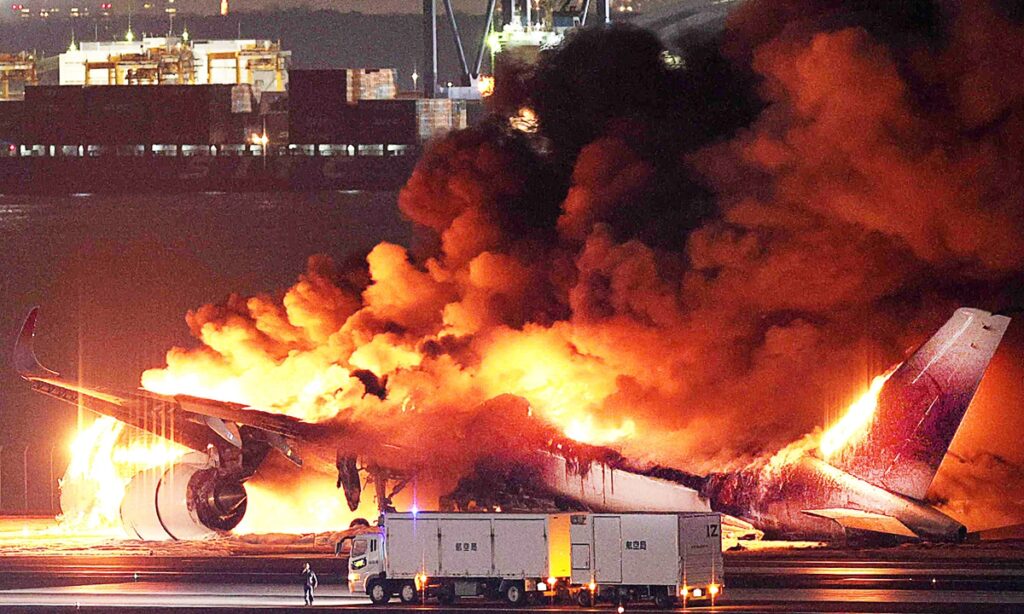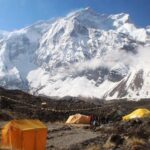Analysts are urging the Japanese government and relevant international organizations, such as the International Atomic Energy Agency (IAEA), to promptly disclose pertinent information and enhance the monitoring of nuclear power plant operations in Japan’s coastal areas.
The 7.6-magnitude quake has caused extensive structural damage and fires in the city of Wajima in Ishikawa Prefecture. Almost 24 hours after the quake struck, there has been limited access to the northern part of the Noto Peninsula as a destroyed road had cut access to the area, according to Japanese media outlets.
Japanese Prime Minister Fumio Kishida said at a press conference on Tuesday that the central government has been coordinating shipments of relief supplies using ships, Kyodo News reported. It also noted that about 1,000 Self-Defense Forces personnel have been dispatched to the worst-hit area for rescue and relief operations.
A Japan Airlines flight carrying hundreds of passengers on Tuesday caught fire on a runway at Tokyo’s Haneda airport after colliding with a Japan Coast Guard aircraft. All 379 passengers and crew escaped, but local media said most of the coast guard plane crew had died. The Coast Guard said the collision involved one of its planes that was headed to Niigata airport on Japan’s west coast to deliver aid to those caught up in a powerful earthquake, according to media reports.
Chinese Foreign Ministry spokesperson Wang Wenbin on Tuesday expressed condolences over the loss of lives and sympathies to the families who have lost loved ones and those who have been injured.
“The Chinese Embassy in Japan and Consulates-General in Nagoya and Niigata immediately activated the emergency response mechanism and issued consular notices. So far there have been no reports of Chinese casualties. The Foreign Ministry and our embassy and consulates in Japan will continue to follow the situation closely and provide timely and necessary assistance to our nationals in Japan,” said Wang.
The quake has also caused injuries and structural damage in Niigata, Toyama, Fukui and Gifu prefectures. Sun Xiao, a Chinese resident living in Toyama Prefecture said he felt the strong quake. “I didn’t expect to experience the biggest earthquake in my life on New Year’s Day in 2024,” Sun told the Global Times.
After the earthquake, the local government of Toyama Prefecture issued a tsunami warning, urging people in coastal areas to immediately evacuate to safe places, Sun said. Although Sun’s house was far from the coast, it was shaking throughout the earthquake, causing items on the bookshelf to fall to the ground.
On Tuesday, the prefecture lifted the tsunami warning, and transportation has been restored. Sun said that local supermarkets and restaurants have reopened, ensuring a steady supply of daily necessities for the residents. Sun has actively participated in volunteer work, translating a disaster prevention manual and assisting in verifying the safety of Chinese individuals residing in the region.
Japan is located at the intersection of multiple tectonic plates and is situated on active faults, so anywhere in Japan is susceptible to earthquakes of magnitude 7 or higher, Xu Xiwei, deputy director of the Institute of Geology at the China Earthquake Administration, told the Global Times on Tuesday.
The earthquake that hit Noto is not located at the boundary of tectonic plates but rather within the plate, so although aftershocks are still occurring, the possibility of aftershocks with higher magnitudes is relatively small, Xu said, noting that although countries such as South Korea and Russia have issued tsunami warnings, it seems that this earthquake in Japan will not have a significant impact on neighboring countries.
The Monday earthquake is one of the most severe earthquakes to have occurred in Japan in recent years. Compared to other countries, Japanese society and its people are well-prepared to deal with earthquakes. If there are no major aftershocks, it will not have a significant impact on Japan’s political and social situation, Da Zhigang, director of the Institute of Northeast Asian Studies at Heilongjiang Provincial Academy of Social Sciences, told the Global Times.
Nuclear disaster haunts
On Tuesday, the Japan Meteorological Agency removed all tsunami warnings for the western coast. The agency first issued a “major tsunami warning” for Noto following the Monday earthquake – the first since the deadly earthquake and tsunami of 2011, but then modified it to a tsunami warning.
Although the tsunami warning has been lifted, there is still a major concern among local residents over whether there will be aftershocks following and whether the nuclear power plants near the Ishikawa Prefecture are safe enough, analysts said.
Japan’s nuclear regulator Nuclear Regulation Authority said on Monday that reactors at Kansai Electric Power’s Ohi and Takahama nuclear stations in Fukui Prefecture, to the north of the main earthquake site in Ishikawa Prefecture, appear not to have been affected by the earthquakes.
The earthquake has caused a significant shock to a vast coastal region in Japan, which includes areas where several nuclear power plants are situated.
Given the previous nuclear disaster in Fukushima, which was triggered by an earthquake followed by a tsunami, it is understandable that people are concerned about the safety of the nuclear power plants in the affected area, Liu Jiangyong, a professor at the Institute of Modern International Relations from Tsinghua University, told the Global Times.
Moreover, there is a growing apprehension regarding the potential impact of the Monday earthquake on the storage of nuclear-contaminated wastewater at the damaged Fukushima nuclear power plant, said Liu.
On March 11, 2011, following a major earthquake, a tsunami disabled the power supply and cooling of three Fukushima Daiichi reactors and caused a major nuclear accident. Tokyo Electric Power Company Holdings, Inc. (TEPCO), which runs the Fukushima power plant, was criticized for delaying reporting the Fukushima meltdown and other mismanagements.
Also on Monday, TEPCO announced that water from the fuel pools at the top floors of the No. 7 and No. 2 reactors at the Kashiwazaki-Kariwa nuclear power plant in Niigata Prefecture spilled over due to strong earthquakes. But no damage or leaks were confirmed.
The international concern is a well-intentioned reminder to the Japanese government over the security of its nuclear power plants. Da noted that TEPCO should make preparations in advance, including checking whether the old nuclear power plants in nearby regions can withstand a larger tsunami or earthquake.
“We cannot let natural disasters and human errors cause a second blow to local resident,” said Da, noting that TEPCO had trapped in scandals with shabby credibility, and although it had voluntarily released information this time, the public still knows little about the severity of the spillover. If a leak occurs, it should be promptly cleaned up, and if it is not serious, preparations should be made in advance.
At the same time, information transparency should be strengthened. Instead of letting TEPCO to dictate everything, the Japanese government should arrange a third-party organization for on-site survey, said Da.
Analysts also called the international community and related agencies, especially the IAEA to strengthen monitoring on situation of the nuclear power plants to ensure security.
In an email reply to the Global Times, the IAEA said that it is in contact with Japan Nuclear Regulation Authority on the Monday earthquake. NRA confirms no abnormalities in nuclear power plants within the affected area. IAEA will continue to monitor the situation.




